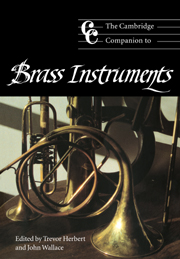Book contents
- Frontmatter
- Introduction
- 1 Lip-vibrated instruments of the ancient and non-western world
- 2 How brass instruments work
- 3 Design, technology and manufacture before 1800
- 4 Brass instruments in art music in the Middle Ages
- 5 The cornett
- 6 ‘Sackbut’: the early trombone
- 7 The trumpet before 1800
- 8 The horn in the Baroque and Classical periods
- 9 Design, technology and manufacture since 1800
- 10 Keyed brass
- 11 The low brass
- 12 Brass in the modern orchestra
- 13 Brass bands and other vernacular brass traditions
- 14 Playing, learning and teaching brass
- 15 The post-classical horn
- 16 Jazz, improvisation and brass
- 17 Brass solo and chamber music from 1800
- 18 Frontiers or byways? Brass instruments in avant-garde music
- Glossary
- Notes
- Select bibliography
- Index
2 - How brass instruments work
Published online by Cambridge University Press: 28 September 2011
- Frontmatter
- Introduction
- 1 Lip-vibrated instruments of the ancient and non-western world
- 2 How brass instruments work
- 3 Design, technology and manufacture before 1800
- 4 Brass instruments in art music in the Middle Ages
- 5 The cornett
- 6 ‘Sackbut’: the early trombone
- 7 The trumpet before 1800
- 8 The horn in the Baroque and Classical periods
- 9 Design, technology and manufacture since 1800
- 10 Keyed brass
- 11 The low brass
- 12 Brass in the modern orchestra
- 13 Brass bands and other vernacular brass traditions
- 14 Playing, learning and teaching brass
- 15 The post-classical horn
- 16 Jazz, improvisation and brass
- 17 Brass solo and chamber music from 1800
- 18 Frontiers or byways? Brass instruments in avant-garde music
- Glossary
- Notes
- Select bibliography
- Index
Summary
All brass instruments consist of a tube, at one end of which is a mouthpiece shaped so that the player can make an airtight seal when the lips are placed against it. The acoustical properties of brass instruments depend on the interactions of the player (in particular the oral cavities and lips), the air column inside the instrument, and the ambient air at the other end of the instrument. The column of air inside the tube is set into vibration when it is excited by the player buzzing his/her lips placed against the mouthpiece. A sustained sound on a brass instrument requires ‘standing waves’, i.e. soundwaves travelling from one end to the other and reflected from each end like water waves in a bath. Although the player opens his/her lips by blowing air through them, because he/she is buzzing his/her lips they are effectively closed for enough of the time to reflect most of the sound waves travelling towards them through the instrument. Whether the other end of the instrument terminates abruptly (as in a bugle) or terminates in a flaring bell (as in a trumpet), sound waves are reflected by the bell mouth or by the flare. The sound inside an instrument is much more intense than the sound produced by the instrument in the surrounding air. The bell of an instrument has to be carefully designed so that it reflects enough sound to allow standing waves to build up, yet allows enough sound to escape to be audible at an appropriate intensity to be useful in music. For this reason, brass instrument bells are of a limited range of patterns - one shaped like a gramophone horn, for example, would not work.
- Type
- Chapter
- Information
- The Cambridge Companion to Brass Instruments , pp. 19 - 23Publisher: Cambridge University PressPrint publication year: 1997
- 2
- Cited by



